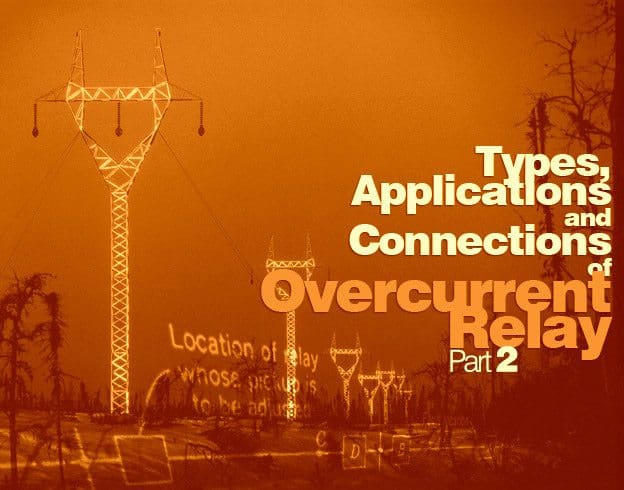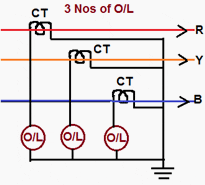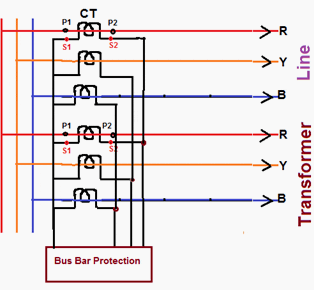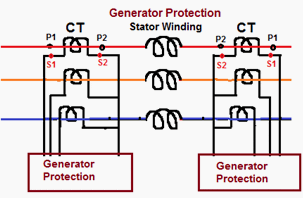 |
Connections Of Overcurrent Relay (part 2)
|
Continued from first part: Types and Applications Of Overcurrent Relay (part 1)
Connections of Overcurrent and Earth Fault Relays
1. 3 Nos O/C relay for overcurrent and earth fault protection
It’s used for:
- 3-phase faults the overcurrent relays in all the 3-phases act.
- Phase to phase faults the relays in only the affected phases operate.
- Single line to ground faults only the relay in the faulty phase gets the fault current and operates.
Even then with 3 overcurrent relays, the sensitivity desired and obtainable with earth leakage overcurrent relays cannot be obtained in as much as the high current setting will have to be necessarily adopted for the overcurrent relay to avoid operation under maximum load condition.
 |
3 Nos O/C Relay for Over Current and Earth Fault Protection
|
Over current relays generally have 50% to 200% current setting while earth leakages over current relays have either 10% to 40% or 20% to 80% current settings.
One important thing to be noted
here is that the connection of the star points of both the C.T.
secondary’s and relay windings by a neutral conductor should be made.
A scheme without the neutral conductor
will be unable to ensure reliable relay operation in the event of
single phase to earth faults because the secondary current in this case
(without star-point interconnection) completes its circuit through relay
and C.T. windings which present large impedance.
This may lead to failure of protection and sharp decrease in reduction of secondary currents by CTs.
It
is not sufficient if the neutral of the CTs and neutral of the relays
are separately earthed. A conductor should be run as stated earlier.
2. 3 No O/C Relay+ 1 No E/F Relay for Overcurrent and Earth Fault Protection
The scheme of connection for 3 Nos Over current Relay 1 No Earth Fault Relay is shown in figure below.
 |
| 3 No O/C Relay+ 1 No E/F Relay for Overcurrent and Earth Fault Protection |
Under
normal operating conditions the three phase fault conditions and
current in the 3-phase are equal and symmetrically displaced by 12 Deg. Hence the sum of these three currents is zero. No current flow through the earth fault relay.
In case of phase to phase faults (say a short between R and Y phases)
the current flows from R-phase up to the point of fault and return back
through ‘Y’ phase. Thus only O/L relays in R and Y phases get the fault
and operate.
Only earth faults cause currents to flow through E/L relay. A note of caution is necessary here. Only either C.T secondary star point of relay winding star point should be earthed.
Earthing of both will short circuit the E/L relay and make it inoperative for faults.
3. 2 No O/C Relay + 1 No E/F Relay for Over Current and Earth Fault Protection
The two over current relays in R and B phases will respond to phase faults. At least one relay will operate for fault involving two phase.
 |
| 2 No O/C Relay + 1 No E/F Relay for Over Current and Earth Fault Protection |
For fault involving ground reliance is placed on earth fault relay.
This is an economical version of 3-O/L and 1-E/L type of protection
as one overcurrent relay is saved. With the protection scheme as shown
in Figure complete protection against phase and ground fault is
afforded.
Current Transformer Secondary Connections
For protection of various equipment of Extra High Voltage class, the star point on secondary’s of CT should be made as follows for ensuring correct directional sensitivity of the protection scheme.
Transmission Line , Bus Bar and Transformer:
- For Transmission Lines – Line side
- For Transformers – Transformer side
- For Bus bar – Bus side
 |
| Transmission Line , Bus Bar & Transformer scheme |
Generator Protection:
- Generator Protection – Generator Side
 |
Generator protection scheme
|
The above method has to be followed irrespective of polarity of CT’s on primary side.
For example, in line protection, if ‘P1’ is towards bus then ‘S2’s are to be shorted and if ‘P2’ is towards bus then ‘S1’s are to be shorted.
Standard Overcurrent and Earth Fault Protection
| No | Name of the Equipment | Protection |
| 1 | 11 KV Feeders | A) 2 No Over Current and one no Earth Fault IDMT relays |
| B) 2 No Instantaneous Overcurrent (highest) and one no Instantaneous Earth fault relay | ||
| 2 | 8 MVA Capacity OR Two Transformer in a Substation (Irrespective of capacity) | HV side: 33 KV Breaker (Individual or Group Control with 3 Over Current and One Earth Fault IDMT relays LV Side: Individual 11 KV Breakers with 3 Over Current and One Earth Fault IDMT relays |
| 3 | 8 MVA Power Transformer | Differential relays OR REF relays on LV side |
| 4 | Only one PTR in a Sub Station (Less than 8 MVA) | HV Side: HG fuse LV Side: 11 KV Breaker with 3 Over Current and one E/F IDMT relay |
No comments:
Post a Comment